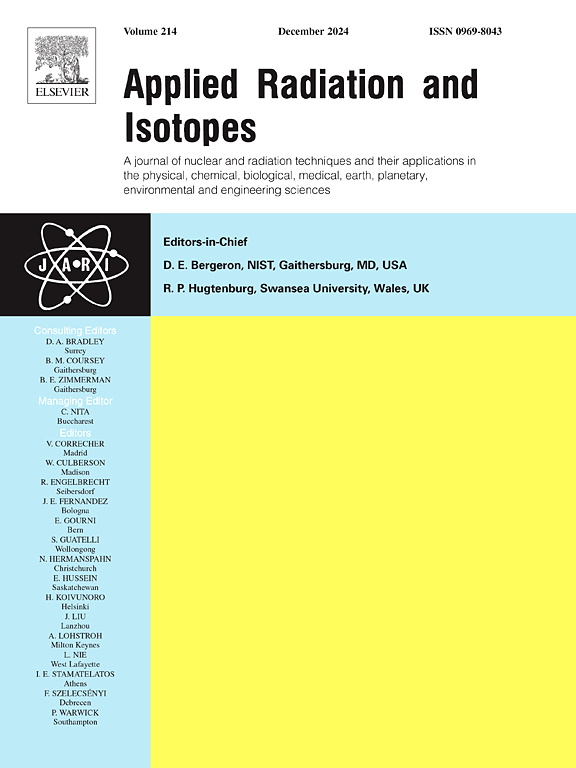Commissioning of the H2 neutron irradiation facility at MARIA research reactor, as a part of MARIA Neutron Laboratory
IF 1.6
3区 工程技术
Q3 CHEMISTRY, INORGANIC & NUCLEAR
引用次数: 0
Abstract
A new neutron beam infrastructure at the MARIA reactor located at the National Centre for Nuclear Research (NCBJ) has recently become installed. Its primary objective is to generate a neutron beam for Boron Neutron Capture Therapy (BNCT). Additionally, it will be utilized for materials research, radiobiology studies, and the development of neutron dosimetry methods.
The construction of the facility has been divided into three main stages related to the assembly of the following parts of the stand: the intermediate channel, the beam shutter, and the converter. Currently, the stage two is coming to an end. The assembly of the beam shutter is finalized and the post-assembly tests are finished. Once the facility licensing is completed, the new beamline will be made available for research purposes.
The shutter is the crucial safety device of the infrastructure. In its closed position, it ensures safe access to the irradiation room during reactor operation at full power. In its open position, it serves as a Beam Shaping Assembly (BSA), collimating the neutron beam. Also, its construction allows for the mounting of a system of filters and moderators to shape the beam spectrum. The completion of the second stage enables the delivery of the thermal neutron beam reaching the flux of 1x109 neutrons/cm2/s. The conclusion of stage three will increase the available range of the neutron energies up to epithermal and fast region.
作为MARIA中子实验室的一部分,MARIA研究堆H2中子辐照设施的调试
位于国家核研究中心(NCBJ)的MARIA反应堆的新中子束基础设施最近已经安装完毕。其主要目标是产生用于硼中子俘获治疗(BNCT)的中子束。此外,它将用于材料研究、放射生物学研究和中子剂量测定方法的发展。该设施的建设分为三个主要阶段,这些阶段与展台以下部分的组装有关:中间通道、光束百叶窗和转换器。目前,第二阶段即将结束。梁式百叶窗的组装完成,组装后的测试完成。一旦设施许可完成,新的光束线将用于研究目的。百叶窗是基础设施的重要安全装置。在其关闭位置,它确保在反应堆全功率运行期间安全进入辐照室。在它的开放位置,它作为一个束整形组件(BSA),准直中子束。此外,它的结构允许安装一个系统的过滤器和调节器来塑造光束光谱。第二阶段的完成使热中子束的输送达到1x109中子/cm2/s的通量。第三阶段的结束将使中子能量的可用范围增加到超低温和快热区。
本文章由计算机程序翻译,如有差异,请以英文原文为准。
求助全文
约1分钟内获得全文
求助全文
来源期刊

Applied Radiation and Isotopes
工程技术-核科学技术
CiteScore
3.00
自引率
12.50%
发文量
406
审稿时长
13.5 months
期刊介绍:
Applied Radiation and Isotopes provides a high quality medium for the publication of substantial, original and scientific and technological papers on the development and peaceful application of nuclear, radiation and radionuclide techniques in chemistry, physics, biochemistry, biology, medicine, security, engineering and in the earth, planetary and environmental sciences, all including dosimetry. Nuclear techniques are defined in the broadest sense and both experimental and theoretical papers are welcome. They include the development and use of α- and β-particles, X-rays and γ-rays, neutrons and other nuclear particles and radiations from all sources, including radionuclides, synchrotron sources, cyclotrons and reactors and from the natural environment.
The journal aims to publish papers with significance to an international audience, containing substantial novelty and scientific impact. The Editors reserve the rights to reject, with or without external review, papers that do not meet these criteria.
Papers dealing with radiation processing, i.e., where radiation is used to bring about a biological, chemical or physical change in a material, should be directed to our sister journal Radiation Physics and Chemistry.
 求助内容:
求助内容: 应助结果提醒方式:
应助结果提醒方式:


